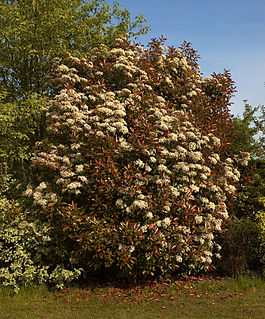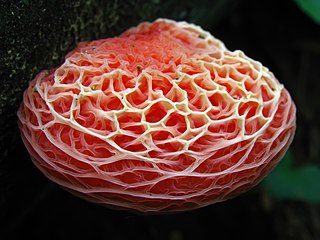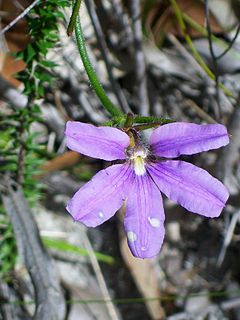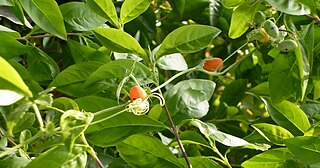
The Cucurbitaceae, also called cucurbits or the gourd family, are a plant family consisting of about 965 species in around 95 genera, of which the most important to humans are:

Iris is a genus of 260–300 species of flowering plants with showy flowers. It takes its name from the Greek word for a rainbow, which is also the name for the Greek goddess of the rainbow, Iris. Some authors state that the name refers to the wide variety of flower colors found among the many species. As well as being the scientific name, iris is also widely used as a common name for all Iris species, as well as some belonging to other closely related genera. A common name for some species is 'flags', while the plants of the subgenus Scorpiris are widely known as 'junos', particularly in horticulture. It is a popular garden flower.

Cucurbita is a genus of herbaceous vines in the gourd family, Cucurbitaceae native to the Andes and Mesoamerica. Five species are grown worldwide for their edible fruit, variously known as squash, pumpkin, or gourd, depending on species, variety, and local parlance, and for their seeds. Other kinds of gourd, also called bottle-gourds, are native to Africa and belong to the genus Lagenaria, which is in the same family and subfamily as Cucurbita, but in a different tribe. These other gourds are used as utensils or vessels, and their young fruits are eaten much like those of Cucurbita species.

Sassafras is a genus of three extant and one extinct species of deciduous trees in the family Lauraceae, native to eastern North America and eastern Asia. The genus is distinguished by its aromatic properties, which have made the tree useful to humans.

Bryonia is a genus of flowering plants in the gourd family. Bryony is its best-known common name. They are native to western Eurasia and adjacent regions, such as North Africa, the Canary Islands and South Asia.

Photinia is a genus of about 40–60 species of small trees and large shrubs, but the taxonomy has recently varied greatly, with the genera Heteromeles, Stranvaesia and Aronia sometimes included in Photinia.

The scarlet gourds are a genus with 25 species. It is distributed in sub-Saharan Africa and with one species, C. grandis also in South and South-east Asia, and it is also introduced into the New World. Incidentally, C. grandis is also a cultivated crop and it is used for culinary and medical purposes.

Oxalis stricta, called the common yellow woodsorrel, common yellow oxalis, upright yellow-sorrel, lemon clover, or more ambiguously and informally "sourgrass" or "pickle plant", is a herbaceous plant native to North America, parts of Eurasia, and has a rare introduction in Britain. It tends to grow in woodlands, meadows, and in disturbed areas as both a perennial and annual. Erect when young, this plant later becomes decumbent as it lies down, and branches regularly. It is not to be confused with similar plants in the same genus which are also often referred to as "yellow woodsorrel".

Momordica dioica, commonly known as spiny gourd or spine gourd and also known as bristly balsam pear, prickly carolaho, teasle gourd, kantola, is a species of flowering plant in the Cucurbitaceae/gourd family. It is used as a vegetable in all regions of India and some parts in South Asia. It has commercial importance and is exported and used locally. The fruits are cooked with spices, or fried and sometimes eaten with meat or fish.It is propagated by underground tubers. It has small leaves, small yellow flowers, it has small, dark green, round or oval fruits.It is dioecious, which means that it has distinct male and female individual organisms, hence its name.

Dendrosicyos is a monotypic genus in the plant family Cucurbitaceae. The only species is Dendrosicyos socotranus, the cucumber tree. The species is endemic to the island of Socotra in Yemen, and is the only species in the Cucurbitaceae to grow in a tree form. The species name was originally spelled D. socotrana, but this is corrected to masculine grammatical gender according to the International Code of Nomenclature for algae, fungi, and plants.

Chloropyron palmatum, formerly classified as Cordylanthus palmatus, is a rare species of flowering plant in the family Orobanchaceae. It is known by the common names of palmate salty bird's-beak and Palmate-bract bird's-beak.

Rhodotus is a genus in the fungus family Physalacriaceae. It is a monotypic genus and consists of the single mushroom species Rhodotus palmatus, known in the vernacular as the netted rhodotus, the rosy veincap, or the wrinkled peach. This uncommon species has a circumboreal distribution, and has been collected in eastern North America, northern Africa, Europe, and Asia; declining populations in Europe have led to its appearance in over half of the European fungal Red Lists of threatened species. Typically found growing on the stumps and logs of rotting hardwoods, mature specimens may usually be identified by the pinkish color and the distinctive ridged and veined surface of their rubbery caps; variations in the color and quantity of light received during development lead to variations in the size, shape, and cap color of fruit bodies.

Auranticarpa rhombifolia is a rainforest tree of eastern Australia. Known as the diamond leaf pittosporum, this tree is planted in many parts of Australia as an ornamental. The white flowers and orange fruit make it a most appealing street or garden tree. Other common names include hollywood, diamond leaf laurel, white myrtle and white holly.

Wilkiea is a genus of dioecious trees and shrubs in the Mollinedieae tribe of the family Monimiaceae. They grow in Australia and New Guinea. Mostly with toothed leaves which have short leaf stems. Leaves with many oil dots. The genus appears to have an Australian or southern origin.

Scaevola ramosissima, known as the purple fan-flower or snake flower, is a small shrub or climber in the family Goodeniaceae, native to south eastern Australia. The habitat is often near the sea, on poor sandy soils frequented by fire. Growing in the eucalyptus forest or heathlands.
Tumamoca macdougalii Rose is a member of the Cucurbitaceae or gourd family. Also called the Tumamoc globeberry, it is native to a very narrow area of the Sonoran Desert, and is found in both Sonora and Arizona. It is one of two species in genus Tumamoca.

Alectryon diversifolius, commonly named scrub boonaree or holly bush, is a species of Australian small trees of the plant family Sapindaceae.
Cucurbita moorei is a plant species of the genus Cucurbita. It is native to the vicinity of Ixmiquilpan, Mexico. It has dark green leaves with white markings and orange flowers.

Ctenolepis garcini, also known as Garcin's bur cucumber, is a tender climber of the family Cucurbitaceae. It is one of the three species of the genus Ctenolepis. It is widely distributed in southern India and Ceylon. The species was named after French botanist Laurent Garcin, who traveled India in the 18th century.

















